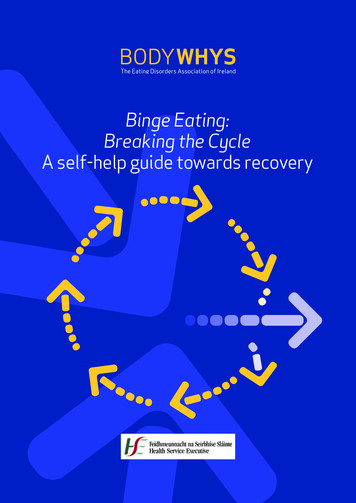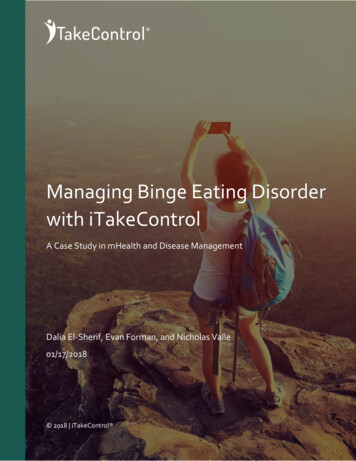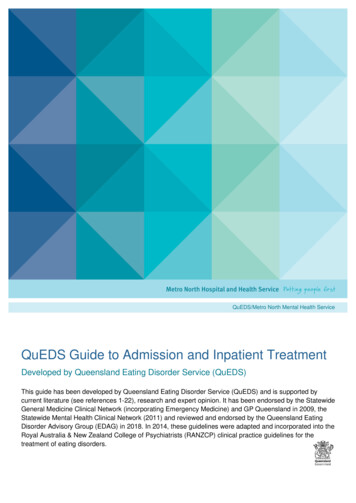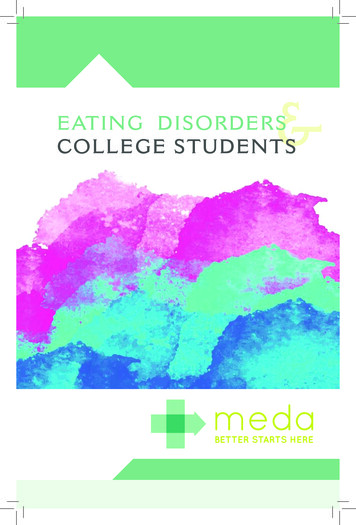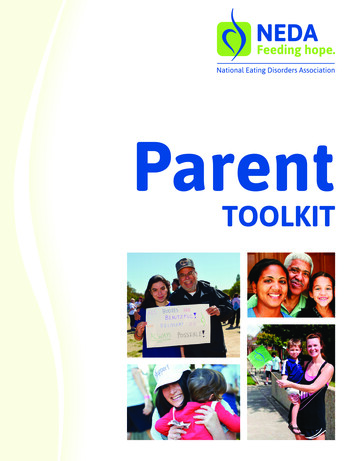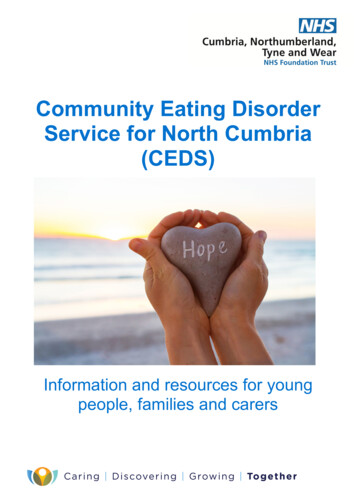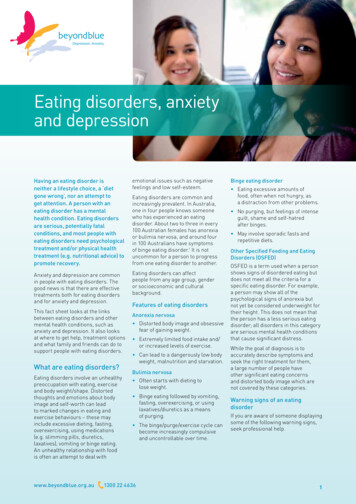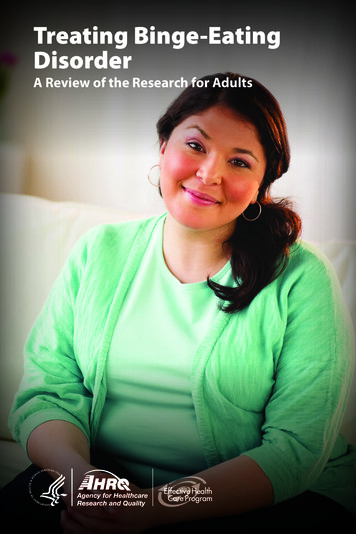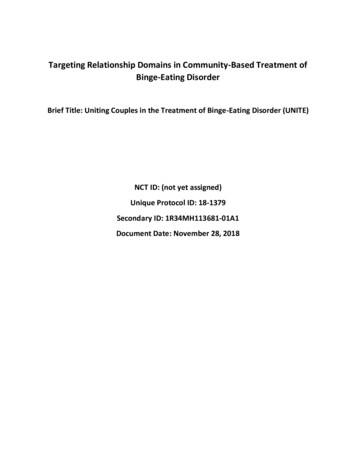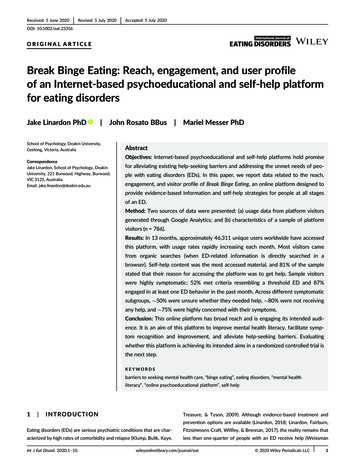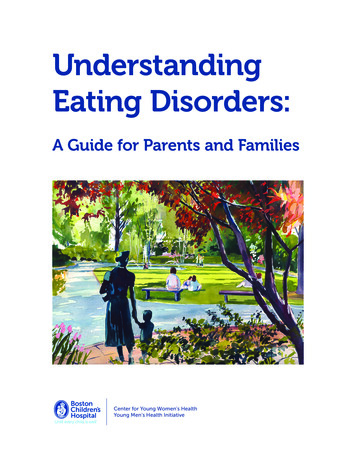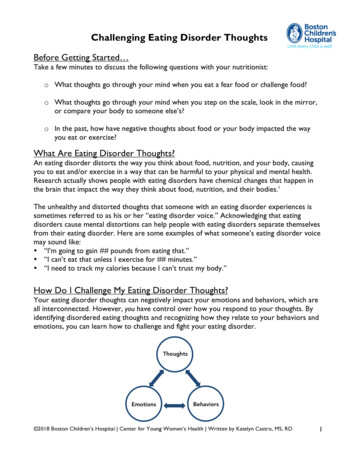
Transcription
Challenging Eating Disorder ThoughtsBefore Getting Started Take a few minutes to discuss the following questions with your nutritionist:o What thoughts go through your mind when you eat a fear food or challenge food?o What thoughts go through your mind when you step on the scale, look in the mirror,or compare your body to someone else’s?o In the past, how have negative thoughts about food or your body impacted the wayyou eat or exercise?What Are Eating Disorder Thoughts?An eating disorder distorts the way you think about food, nutrition, and your body, causingyou to eat and/or exercise in a way that can be harmful to your physical and mental health.Research actually shows people with eating disorders have chemical changes that happen inthe brain that impact the way they think about food, nutrition, and their bodies.1The unhealthy and distorted thoughts that someone with an eating disorder experiences issometimes referred to as his or her “eating disorder voice.” Acknowledging that eatingdisorders cause mental distortions can help people with eating disorders separate themselvesfrom their eating disorder. Here are some examples of what someone’s eating disorder voicemay sound like: “I’m going to gain ## pounds from eating that.” “I can’t eat that unless I exercise for ## minutes.” “I need to track my calories because I can’t trust my body.”How Do I Challenge My Eating Disorder Thoughts?Your eating disorder thoughts can negatively impact your emotions and behaviors, which areall interconnected. However, you have control over how you respond to your thoughts. Byidentifying disordered eating thoughts and recognizing how they relate to your behaviors andemotions, you can learn how to challenge and fight your eating disorder. 2018 Boston Children’s Hospital Center for Young Women’s Health Written by Katelyn Castro, MS, RD1
Strategies To Recognize and Challenge Your Eating Disorder1. Limit and Eventually Replace Unhealthy BEHAVIORSWork with your nutritionist to start to recognize your disordered behaviors and transition tohealthy eating and exercise behaviors. Every step you take towards positive behavior changesallows you to become more comfortable and confident in your ability to break away fromunhealthy behaviors and separate yourself from your eating disorder. Here are someexamples of unhealthy and healthy eating and exercise behaviors:Questions for You:o What is one unhealthy behavior around eating or exercise that you could work onreplacing with a healthier behavior?o What steps could you take to reach this goal?2. Recognize and Challenge Disordered THOUGHTSYour eating disorder voice often gets louder when you start refraining from disordered eatingand exercise behaviors. Learning how to recognize your eating disorder voice is extremelyimportant so that you can fight this voice and continue working towards healthy habits. Allor-nothing thinking, over-generalizing, and over-exaggerating negative aspects are all examplesof distorted thought patterns. Your eating disorder treatment team can help you becomemore aware of your eating disorder distortions and reframe disordered thoughts into morerational and healthy thoughts about food and your body. 2018 Boston Children’s Hospital Center for Young Women’s Health Written by Katelyn Castro, MS, RD2
Here are a few examples of eating disorder thoughts and ways to reframe them: 2018 Boston Children’s Hospital Center for Young Women’s Health Written by Katelyn Castro, MS, RD3
Questions for You:o What is one thing that your eating disorder often tells you?o What could be a healthy alternative thought that you could say in response?But What if I Can’t Think of a Healthy Alternative Thought?It’s common to be overcritical and unforgiving towards yourself while being supportive andcompassionate to your friends and family. If you’re finding it difficult to think of healthyalternative thoughts to replace disordered thoughts, ask yourself these questions: What would you say to a friend if he/she talked to himself/herself this way? What would you say if a three year old talked about him/herself this way?3. Find Positive Ways to Cope with Your FEELINGS:At some point, your eating disorder may have helped you handle difficult situations andemotions so it’s normal to feel more anxious and uncomfortable in your body when you stopusing disordered eating behaviors. To avoid returning to past disordered behaviors inunfamiliar and stressful situations, it’s important to work with your therapist or psychologistto find healthy ways to identify and cope with your emotions.Positive coping strategies look different for everyone so trying out different strategies canhelp you figure out what works best for you in different situations. Here are a few examples:Relaxation: Deep breathing – Guided meditation – Progressive muscle relaxationActivity: Play with a pet – Draw – Watch TV – Read a book – Listen to music– Talk to a friendSelf Soothe: Take a bath or shower – Squeeze a ball – Peel an orange – Lotion your handsReframe Thoughts: Repeat a mantra (“I can do this”) – Remind self of goal (full recovery)Other coping skills: 2018 Boston Children’s Hospital Center for Young Women’s Health Written by Katelyn Castro, MS, RD4
Here are two scenarios where teens have learned how to use positive coping skills to managetheir emotions and fight their eating disorder voice:Scenario #1: Alex and his anxiety around cake.Alex is at his friend’s birthday party and is offered a slice of cake. Alex hasn’t eaten cake in ayear because it was previously a fear food for him and he feels anxious eating.Coping Strategy: While Alex ate a slice of cake, he distracted himself from his eatingdisorder thoughts by talking with his friend at the table. When his eating disorder voicestarted to takeover with negative thoughts, he counted to ten, took a deep breath, and toldhimself “the more I fight my eating disorder, the easier it will get. I can get through this.”Scenario #2: Brie and her urge to binge eat when depressed.Brie is home alone watching TV a few hours after dinner and is feeling sad. Brie used to bingeeat cookies and candy when she was feeling lonely and in between diets.Coping Strategy: Brie turned off the TV, put a few cookies on a plate, poured a glass of milk,and sat at the table enjoying her snack. After eating and feeling satisfied with her snack, shewent to her room to talk to her friend on her phone.Questions for You:o In what situations do you find it hardest to fight your eating disorder behaviors?o What do you think are one or two coping strategies that could help you get through thesesituations?Remember: Ride the WaveSometimes, no matter how hard you may try to deal with your emotions, there may benothing that you can do to change how you’re feeling in the moment. You simply have to ridethe wave, let your emotions come and go, and know that what you’re feeling in the momentis only temporary. Learning how to sit with the discomfort is an important skill in eatingdisorder recovery. Every time you challenge your eating disorder voice, you will feel moreconfident in your ability to fight your eating disorder. 2018 Boston Children’s Hospital Center for Young Women’s Health Written by Katelyn Castro, MS, RD5
What Does This Mean For Me?Take a few minutes to think through the information shared in this handout and answer thequestions listed below:1. What can I start doing to help me challenge my eating disorder thoughts and focus onhealthy eating goals?2. What could I start doing to help me process and cope with my emotions?3. Who could I ask to support me in meeting these goals?To Learn More:Recovery Warriors- Eating Disorder Recovery Support: recoverywarriors.comThe Body Positive: www.thebodypositive.orgScritchfield, R. Body Kindness (2016) and website (www.bodykindnessbook.com)Schaefer, J. Goodbye Ed, Hello Me (2009).Herrin M, Matsumoto N. The Parent’s Guide to Eating Disorders (2010).References:Avena, Nicole M., and Miriam E. Bocarsly. "Dysregulation of brain reward systems in eatingdisorders: neurochemical information from animal models of binge eating, bulimia nervosa,and anorexia nervosa." Neuropharmacology 63.1 (2012): 87-96.Dalle Grave, Riccardo, et al. "Enhanced cognitive behaviour therapy for adolescents withanorexia nervosa: an alternative to family therapy?." Behaviour research and therapy 51.1(2013): R9-R12.Lock, James. "An update on evidence-based psychosocial treatments for eating disorders inchildren and adolescents." Journal of Clinical Child & Adolescent Psychology 44.5 (2015): 707-721. 2018 Boston Children’s Hospital Center for Young Women’s Health Written by Katelyn Castro, MS, RD6
Coping Strategy: While Alex ate a slice of cake, he distracted himself from his eating disorder thoughts by talking with his friend at the table. When his eating disorder voice started to takeover with negative thoughts, he counted to ten, took a deep breath, and told himself "the more I fight my eating disorder, the easier it will get. I can .
